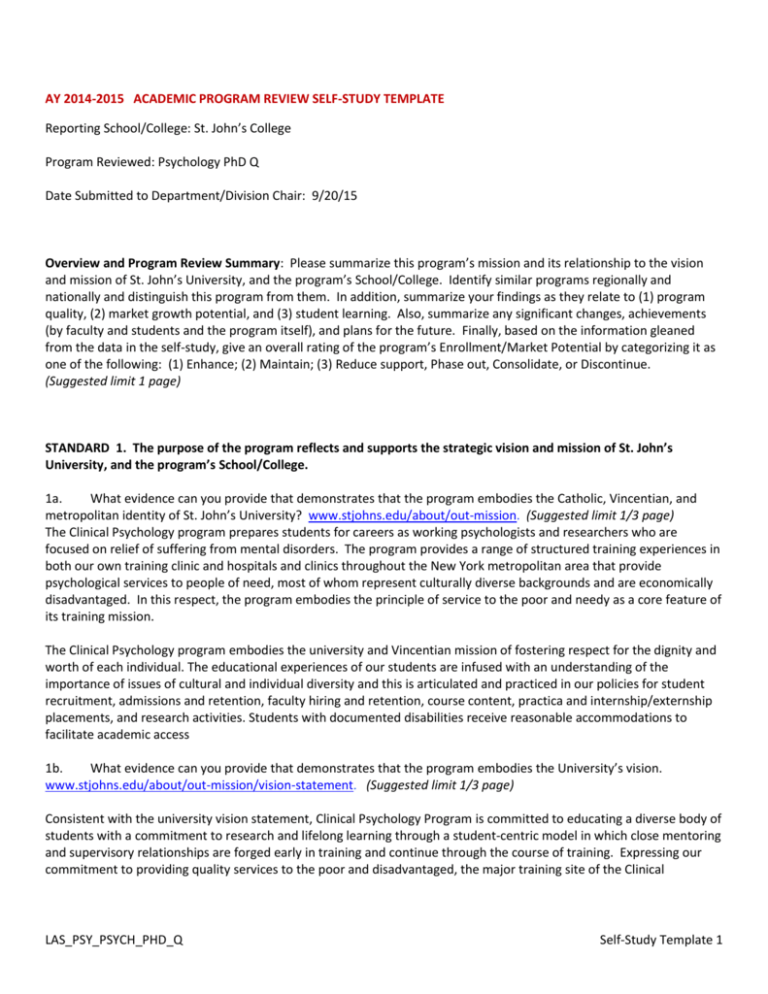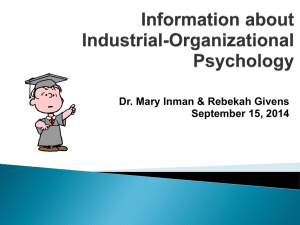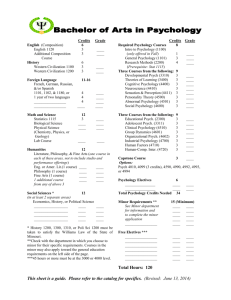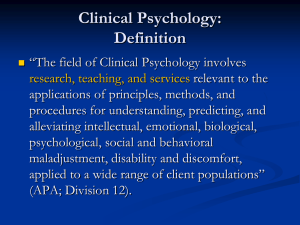Psychology - St. John`s University
advertisement

AY 2014-2015 ACADEMIC PROGRAM REVIEW SELF-STUDY TEMPLATE Reporting School/College: St. John’s College Program Reviewed: Psychology PhD Q Date Submitted to Department/Division Chair: 9/20/15 Overview and Program Review Summary: Please summarize this program’s mission and its relationship to the vision and mission of St. John’s University, and the program’s School/College. Identify similar programs regionally and nationally and distinguish this program from them. In addition, summarize your findings as they relate to (1) program quality, (2) market growth potential, and (3) student learning. Also, summarize any significant changes, achievements (by faculty and students and the program itself), and plans for the future. Finally, based on the information gleaned from the data in the self-study, give an overall rating of the program’s Enrollment/Market Potential by categorizing it as one of the following: (1) Enhance; (2) Maintain; (3) Reduce support, Phase out, Consolidate, or Discontinue. (Suggested limit 1 page) STANDARD 1. The purpose of the program reflects and supports the strategic vision and mission of St. John’s University, and the program’s School/College. 1a. What evidence can you provide that demonstrates that the program embodies the Catholic, Vincentian, and metropolitan identity of St. John’s University? www.stjohns.edu/about/out-mission. (Suggested limit 1/3 page) The Clinical Psychology program prepares students for careers as working psychologists and researchers who are focused on relief of suffering from mental disorders. The program provides a range of structured training experiences in both our own training clinic and hospitals and clinics throughout the New York metropolitan area that provide psychological services to people of need, most of whom represent culturally diverse backgrounds and are economically disadvantaged. In this respect, the program embodies the principle of service to the poor and needy as a core feature of its training mission. The Clinical Psychology program embodies the university and Vincentian mission of fostering respect for the dignity and worth of each individual. The educational experiences of our students are infused with an understanding of the importance of issues of cultural and individual diversity and this is articulated and practiced in our policies for student recruitment, admissions and retention, faculty hiring and retention, course content, practica and internship/externship placements, and research activities. Students with documented disabilities receive reasonable accommodations to facilitate academic access 1b. What evidence can you provide that demonstrates that the program embodies the University’s vision. www.stjohns.edu/about/out-mission/vision-statement. (Suggested limit 1/3 page) Consistent with the university vision statement, Clinical Psychology Program is committed to educating a diverse body of students with a commitment to research and lifelong learning through a student-centric model in which close mentoring and supervisory relationships are forged early in training and continue through the course of training. Expressing our commitment to providing quality services to the poor and disadvantaged, the major training site of the Clinical LAS_PSY_PSYCH_PHD_Q Self-Study Template 1 Psychology program, the St. John’s University Center for Psychological Services offers a wide range of psychological services to a generally low-income, multiethnic community in central Queens, New York on a modest sliding-fee scale. The program also reflects the mission of student engagement by the high degree of individual attention provided to doctoral students in the program. Also, doctoral students work as doctoral fellows, some of them in areas where they have contact with undergrad students. The graduate students help the faculty to have more time to devote to our undergraduate students. The program also reflects the global mission of the university by the diversity represented in the student body, the cross cultural research done by the students, and the students’ practica, externships and internships with immigrant populations. 1c. What evidence can you provide that demonstrates that the program embodies the vision and mission of the program’s School/College? (Suggested limit 1/3 page) The Clinical Psychology program is the largest and most well established Ph.D. program in the College of Liberal Arts and Sciences. The program embodies the College’s commitment to excellent in training and scholarship. Standard 1. Additional comments if needed. (Suggested limit 1 page) STANDARD 2. The program attracts, retains, and graduates high quality students. 2a. Undergraduate SAT and High School Average 2b. Undergraduate 1st Year Retention Rate 2c. Undergraduate 6 Year Graduation Rate 2d. Graduate Standardized Test Scores Fall 2005 2006 2007 2008 2009 Program 633/677 616/688 636/677 572/647 630/707 School/College Average Rate 481/561 494/569 465/551 501/588 472/577 Regional N/A N/A N/A N/A N/A Comparison See below National Comparison LAS_PSY_PSYCH_PHD_Q Self-Study Template 2 New Graduate Students GRE Verbal Mean Scores Fall 2010 Fall 2011 Fall 2012 Fall 2013 Ir Grev Score Ir Grev Score Ir Grev Score Ir Grev Score Psychology PHD old 653 639 new New Graduate Students GRE Quantitative Mean Scores Fall 2010 Fall 2011 Fall 2012 650 620 163 166 Fall 2013 Ir Greq Score Ir Greq Score Ir Greq Score Ir Greq Score Psychology PHD old 693 705 687 718 157 160 new As of August 1, 2011, ETS revised the GRE General Test with a new scoring scale. Prior to 8/1/11 on a scale of 200-800(old) and after 8/1/11 on a scale of 130-170(new) Based on students with valid scores in BANNER - therefore it maybe small in some cases. New Graduate Students GRE Verbal Mean Scores Fall 2010 Fall 2011 Fall 2012 Fall 2013 Graduate School Arts & Sci old new Ir Grev Ir Grev Ir Grev Ir Grev Score Score Score Score 491 500 497 532 154 153 New Graduate Students GRE Quantitative Mean Scores Fall 2010 Fall 2011 Fall 2012 Fall 2013 Graduate School Arts & Sci old Ir Greq Ir Greq Ir Greq Ir Greq Score Score Score Score 585 566 593 604 new 149 150 As of August 1, 2011, ETS revised the GRE General Test with a new scoring scale. Prior to 8/1/11 on a scale of 200-800(old) and after 8/1/11 on a scale of 130-170(new) LAS_PSY_PSYCH_PHD_Q Self-Study Template 3 2% 2e. Please describe how the program compares with peer and aspirational institutions. (Suggested limit 1/2 page) We benchmark our program against Fordham University and Teachers College of Columbia University as aspirational institutions and against all other NYC programs as local competition. According to the latest reported NY Licensure pass rates on the NY Psychology Licensure examination, the St. John’s Clinical Psychology program (95.65% pass rate) surpasses ALL other NYC programs, including Fordham (89.06%) and Columbia teachers College (87.76%). The Clinical Psychology program registered an 85.11% match rates for the national internship match for the period 20112014, which is only marginally lower than Fordham (86.96%) and substantially higher than Teachers College, Columbia University (65.63%). We exceed all other NYC programs excepting a virtual tie with the New School (85.48%) 2f. If applicable, describe the program’s student performance over the past five years on licensure or professional certification exams relative to regional and national standards. (Suggested limit 1/4 page) See directly above. Although there are no national statistics reported for licensure, the Clinical Psychology program registers a high rate (87%) of licensure of graduates for the ten year period, 2002-2012. 2g. Number of majors and minors enrolled over the past five years. See table below. Fall Number of Students Majors Minors Total MAJORS 2005 2006 76 0 76 2008 64 0 64 2009 67 0 67 67 0 67 Fall 2010 Fall 2011 Fall 2012 Fall 2013 Majors Majors Majors Majors PSY2 PHD 38 36 34 30 PSY3 PHD 28 30 30 30 66 66 64 60 Total 2h. 2007 69 0 69 Number of degrees granted during the past five years. See table below. Degrees Granted LAS_PSY_PSYCH_PHD_Q 2005 2006 Academic Year 2007 2008 2009 Self-Study Template 4 PHD 17 17 13 10/11 SJC-GR PSY2 PSY3 Clinical Psy-General Track PHD Clinical Psy-Clin Child Track PHD Total 8 11/12 10 12/13 Degrees Degrees Degrees Conferred Conferred Conferred 4 8 8 4 5 6 8 13 14 Below is comparison degrees conferred data for local and national institutions based on data retrieved from the IPEDS website. This is based on the Classification of Instructional Program (CIP) Code of 42-Psychology. 20092010 20102011 20112012 Doctorate Local 180 174 178 National 5,540 5,851 5,928 1 Local institution include: Adelphi University, Columbia University, CUNY Queens College, Fordham University, Hofstra University, Iona College, C.W. Post University, Manhattan College, New York University, Pace University, Seton Hall University, Stony Brook University, and Wagner College. Comments : Based on the data in 2g and 2h, how do these trends compare to institutional, regional and national patterns? (Suggested limit 1/2 page) 2i. What mechanisms are in place to monitor students’ progress toward degree? And, to what extent is there a collaborative effort to provide quality advising and support services to students? (Suggested limit 1/4 page) Student progress is regularly monitored through a variety of means, including review of grades, supervisor evaluations, completion of milestones such as successful completion of a Master’s thesis, Doctoral Dissertation, Doctoral LAS_PSY_PSYCH_PHD_Q Self-Study Template 5 Comprehensive Examination, and full year psychology internship. Advisement is multifaceted and involves several faculty members, including the assigned academic advisor, the clinical director, and the Master’s and Doctoral dissertation mentors. 2j. If available, provide information on the success of graduates in this program as it relates to employment or attending graduate school. (Suggested limit 1/4 page) By and large, our graduates hold positions as working psychologists in a wide range of mental health care facilities, including hospitals, community clinics and mental health centers, state psychiatric centers, and university settings. According to our most recent alumni survey (Spring 2014), the most common employment sites for initial employment are medical centers (16%) and state/county hospitals (13%), followed by community clinics and mental health centers (12%). For current employment, the most sites are community clinics/mental health centers and independent practice (12% each) and medical centers (12%). Overall, among the 45 alumni who graduated from 2007 to 2013 who responded to our most recent (2014) alumni survey, 42 (93%) are working in the field and 3 (7%) report not currently employed. 2k. Please comment on the students’ competencies in the program. Support your response using data provided below and any other data available. (Suggested limit 1/3 page) A minimal level of competency in meeting clinical training objectives requires practicum and externship supervisor ratings of “moderately” or higher on Foundational Competencies and “meets or exceeds expectations” on additional SJU Specific Criteria. A review of the most recent academic year, 2013-2014, shows that 100% of students in residence (Years 1-4) met these requirements. In addition, all intern level students since the last formal APA review (2008) have received satisfactory ratings from their internship supervisors and successfully completed their internship year. We believe these proximal outcome data provide strong evidence that our students acquire expected competencies in the field. Moreover, the pass rate for Doctoral Comprehensive Examination for the period 2008-2014 was 94.8% (73 of 77 passing). As of the 2013-2014 academic year, all students who failed the exam on the first attempt passed on the second. In addition, all students must receive a grade of B or better on all required courses in the doctoral program. Students who received less than a B grade are required to retake the course. LAS_PSY_PSYCH_PHD_Q Self-Study Template 6 Standard 2. Additional comments if needed: (Suggested limit 1 page) STANDARD 3. The program engages in ongoing systematic planning that is aligned with the University and School/College planning, direction, and priorities. 3a. How does your program’s strategic goal/objectives link to your School/College plan and the University’s strategic plan? http://www.stjohns.edu/about/leadership/strategic-planning Consistent with the stated goals and objectives in the College and Department strategic planning objectives, the Clinical Psychology program focuses on the teaching of applied clinical skills. The quality of the training program is regularly reviewed for accreditation by the American Psychological Association. The next anticipated formal site visit is expected in Spring, 2015. 3b. What is the evidence of monitoring the external and internal environments, specifically what are the strengths, weaknesses, opportunities and threats facing the program? How were they identified? What actions have been taken in response to these findings? What characteristics of the program suggest a competitive edge against other programs regionally and nationally? The program continues to excel in bringing high caliber students who seek careers in clinical psychology. As the health care environment changes, we need to meet these challenges and maintain our competitive edge by providing cutting edge training opportunities, such as working with a world-class researcher scholar, Dr. Elissa Brown, in providing empirically tested psychological treatment for children who have suffered abuse. Moreover, in meeting new demands LAS_PSY_PSYCH_PHD_Q Self-Study Template 7 for clinical psychologists, we are developing initiatives, working with faculty member Dr. Elizabeth Brondolo, to train clinical psychology to work as consultants in primary care facilities in hospital settings. We are also expanding external research training affiliations, such as through Dr. Jeffrey Nevid’s collaborative work at Nassau University Medical Center and Dr. William Chaplin’s work at Columbia Presbyterian Medical Center. We believe that these outreach efforts will provide our students with a competitive advantage in competing for postdoctoral fellowships and employment opportunities. 3c. What is the current and future market demand for the program? Support your response using the data provided below or any other internal or external sources to justify your response. Demand continues to be strong, as we regularly attract between 300 and 400 or so applications per year for 10 open positions in the incoming class. We expect this market demand will continue, as the program is widely recognized for providing quality training in skills relating to clinical practice and research needed to prepare clinical psychologists in today’s changing health care environment. Change, 2010-20 Fastest Growing Occupations Psychologists Percent Numeric 22% 37,700 Occupations having the largest numerical increase in employment Psychologists Change, 2010-20 Percent Numeric 22% 37,700 Changes, 2010-20 Grow faster than average - Increase 15 to 20.9% Psychologists Percent Numeric 22% 37,700 *For more information please visit: http://www.bls.gov/news.release/ecopro.toc.htm Standard 3. Additional comments if needed: (Suggested limit 1 page) STANDARD 4. The program provides a high quality curriculum that emphasizes and assesses student learning and engagement. 4a. Please indicate how the program curriculum is in alignment with the following three items: (Suggested limit 1/2 page for each of the three categories below) 1. Standards within the discipline 2. Curriculum integrity, coherence, academic internships, teaching excellence, teaching vibrancy, and study abroad experiences. 3. The University Core competencies LAS_PSY_PSYCH_PHD_Q Self-Study Template 8 The clinical psychology program adheres to specified curriculum requirements set by both NSYED for registration of doctoral programs in psychology and by the American Psychological Association for accreditation of clinical psychology programs. The clinical program has successfully maintained state registration so that graduates are automatically eligible for sitting for the NYS licensure examination (after submitting acceptable experience post-doctoral) and full accreditation awarded by the American Psychological Association based on formal periodic reviews conducted since 1984. 4b. The syllabi for the courses within this program incorporate the suggested elements of a syllabus – an example of which can be found at the following St. John’s University Center for Teaching and Learning link. (Suggested limit 1/3 page) http://stjohns.campusguides.com/content.php?pid=71651&sid=984766 All syllabi meet APA requirements for preparation of acceptable syllabi and are posted online in edigication. 4c. Describe the assessment model currently in place for the program and indicate the extent to which disciplinary and core knowledge, competence, and values are met, as well as findings and action plans for improvement. For reference, visit WeaveOnline – https://app.weaveonline.com//login.aspx; Digication – https://stjohns.digication.com (Suggested limit 1/2 page) 4d. What, if any, external validations, e.g. specialized accreditations, external awards, other validations of quality has the program received? (Suggested limit 1/3 page) The Clinical Psychology program has been continuously fully accredited by the American Psychological Association since 1984. This is the highest level of credentialing in professional psychology. Standard 4. Additional comments if needed. (Suggested limit 1 page) STANDARD 5. The program has the faculty resources required to meet its mission and goals. 5a. Below you will find the number of students enrolled as majors and minors in the program. Please complete the table by adding the number of full-time faculty assigned to the program. Then calculate the student to full-time faculty ratio. # Majors/ FT Faculty Majors Fall 2005 FT 35 PT 41 Fall 2006 Total 76 Minors Majors & Minors Combine FT 44 PT 25 Total 69 0 41 LAS_PSY_PSYCH_PHD_Q 76 Fall 2007 FT 39 PT 25 Total 64 0 44 25 69 Fall 2008 FT 35 PT 32 Fall 2009 Total 67 0 39 25 64 FT 45 PT 22 Total 67 0 35 32 67 0 45 22 67 Self-Study Template 9 d # of FTE Students (Majors & Minors) 35.0 0 13.6 7 48.6 7 44.0 0 8.3 3 52.3 3 39.0 0 8.3 3 47.3 3 35.0 0 10.6 7 45.6 7 45.0 0 7.3 3 52.3 3 # of FTE Faculty assigned to the program 7.17 2.67 9.84 6.67 4 10.6 7 7.5 3.6 7 11.1 7 7.5 3.67 11.1 6 7.67 2.3 3 10.0 FTE Student/ FTE Faculty Ratio 4.9 4.9 Fall 2010 F MAJORS Fall 2011 P Majors 4.24 Total F P 5.23 Fall 2012 Total F P Fall 2013 Total F P Total Majors Majors Majors Majors Majors Majors Majors Majors Majors Majors Majors 35 31 66 45 21 Fall 2010 Total 4.09 FTE MAJORS 66 38 Fall 2011 26 64 35 Fall 2012 25 60 Fall 2013 F P Total F P Total F P Total F P Total FTE FTE FTE FTE FTE FTE FTE FTE FTE FTE FTE FTE 45 7 52 38 35 10.333 45.333 Fall 2010 Fall 2011 8.667 46.667 Fall 2012 35 8.333 43.333 Fall 2013 # of FTE faculty assigned to the program LAS_PSY_PSYCH_PHD_Q Self-Study Template 10 FTE Student/FTE Faculty Ratio Important Notes: FTE Students = Number of FT Students + (number of PT Students/3) FTE Faculty = Number of FT Faculty + (number of PT Faculty/3) This methodology is used by STJ for all external reporting. 5b. Below you will find the credit hours the department has delivered by full-time faculty and part-time faculty (including administrators) and the total credit hours consumed by non-majors. Credit Hours Taught FT Faculty PT Faculty Total Fall 2005 # % 4860 69% Fall 2007 # % 4598 67% Fall 2008 # % 4911 71% 2139 31% 2244 32% 2262 33% 2010 29% 6999 100% 6977 100% 6860 100% 6921 100% % consumed by NonMajors/Min ors Credit Hrs Taught Fall 2006 # % 4733 68% 25% 24% Fall 2010 Number Percent 23% Fall 2011 Number Percent Fall 2009 # % 5465 76% 1719 7184 22% 24% 100% 20% Fall 2012 Fall 2013 Number Percent Number Percent F-T Faculty 5,048 65.4% 4,736 58.4% 5,108 65.6% 4,687 63.3% P-T Faculty (inc Admin) 2,665 34.6% 3,370 41.6% 2,684 34.4% 2,721 36.7% 0.0% 0.0% 0.0% Total 7,713 100% 8,106 100% % Consumed by NonMajors 1,716 22.2% 1,891 23.3% 1,819 LAS_PSY_PSYCH_PHD_Q 7,792 100% 0.0% 7,408 23.3% 1,436 100% 19.4% Self-Study Template 11 5c. Below you will find the number of courses the department has delivered by full-time faculty and part-time faculty (including administrators). Courses Taught Fall 2010 Fall 2011 Fall 2012 Fall 2013 Number Percent Number Percent Number Percent Number Percent F-T Faculty 63 66.3% 100 62.1% 69 69.7% 65 61.3% P-T Faculty (inc Admin) 32 33.7% 61 37.9% 30 30.3% 41 38.7% Total 95 0.0% 0.0% 0.0% 100% 161 100% 99 100% 0.0% 106 100% 5d. What is the representative nature of faculty in terms of demographics, tenure and diversity? (See departmental information on next page). How well does this support the program? (Suggested limit 1/2 page) The clinical psychology program currently consists of 11 identified core faculty members (Ds. Bergman, Brondolo, Brown, Chaplin, DelVecchio, DiGiuseppe, Greene, Javier, McDermut, Nevid, and Pope), five men and six women, including three ethnic minority faculty members, , Drs. Rafael Javier, Tamara DelVecchio,and Beverly Greene. All 11 are tenured and all are at the associate or full professor level. The program is also supported by 6 additional faculty members in support roles and by 4 adjunct faculty members to meet particular training needs in the program. Overall the program has adequate faculty support and resources to meet its training objectives. LAS_PSY_PSYCH_PHD_Q Self-Study Template 12 Departmental Data FT # Gender Male Female Total % 2010 PT # % 15 52% 12 46% 14 48% 14 54% 29 26 Ethnicity Black 3 10% 0% Hispanic 5 17% 1 4% Asian 1 3% 0% American Indian/Alaskan Native 0% 0% White 20 69% 24 92% 2 or More Races Native Hawaiian/Pacific Islander Unknown 0% 1 4% Total 29 26 Tenure Status Tenured Tenure-Track Not Applicable Total 23 79% 5 17% 1 3% 29 LAS_PSY_PSYCH_PHD_Q Total FT # % 2011 PT # % Total FT # % 2012 PT # % Total FT # % 2013 PT # % Total 27 28 55 15 52% 12 48% 14 48% 13 52% 29 25 27 27 54 15 52% 13 43% 14 48% 17 57% 29 30 28 31 59 16 52% 16 53% 15 48% 14 47% 31 30 32 29 61 3 6 1 3 5 1 0% 0% 4% 3 5 2 3 5 2 0% 7% 7% 3 7 4 3 5 2 3% 10% 7% 4 8 4 0 44 0% 0% 20 69% 23 92% 0 43 0% 0% 19 66% 25 83% 0 44 0% 0 0% 21 68% 23 77% 0 0% 0 44 0 10% 17% 3% 1 55 0% 29 23 5 1 29 23 79% 5 17% 1 3% 29 1 1 25 4% 10% 17% 7% 1 54 0% 29 23 5 1 29 26 90% 2 7% 1 3% 29 2 2 1 30 3% 10% 16% 6% 1 59 0% 31 26 2 1 29 28 90% 2 6% 1 3% 31 1 3 2 0 1 30 0% 3% 0 1 61 28 2 1 31 Self-Study Template 13 5e. What evidence exists that the program’s faculty have engaged in research and scholarship on teaching and/or learning in the program’s field of study? (Suggested limit 1/2 page) Each of the core faculty members is an active and productive scholar or researcher. With respect to research on the scholarship of teaching, the clinical director, Dr. Nevid, is a Fellow of the APA division on the teaching of psychology and has published extensively on effective pedagogical techniques in the leading professional journal in the field, Teaching of Psychology. 5f. What initiatives have been taken in the past five years to promote faculty development in support of the program? (Suggested limit 1/2 page) All of the core faculty members have received research reductions and assignments of doctoral fellows during the past five years to help support them in pursuing their research and scholarly activities. 5g. The table below shows the amount of external funding received by the department. If available, please provide the dollar amount of externally funded research for full-time faculty supporting the program under review. (Program dollar amounts are available through departmental records.) Please consult with the university Office of Grants and Funded Research for the dollar amounts. 5h. Please comment on the table below that shows trends in overall course evaluation and instructional vibrancy for your program (if available), your college and the university. (Suggested limit ½ page) Overall Evaluation (Spring) 2011 2012 2013 Instructional Vibrancy (Spring) 2011 2012 2013 Psychology (Q) 4.24 4.24 3.99 4.33 4.37 4.23 Saint John’s College 4.23 4.26 4.19 4.37 4.40 4.40 Total Graduate 4.14 4.16 4.30 4.37 4.39 4.52 Note: Institutional Vibrancy is the average of the first 14 questions on the course evaluation, with questions pertaining to course organization, communication, faculty-student interaction, and assignments/grading. All course evaluation questions range from 1 (Strongly Disagree) to 5 (Strongly Agree). 5i. What percentage of full time faculty assigned to this program have terminal degrees or industry certifications renewed within the past 2 years? Comment. (Suggested limit 1/3 page) All core faculty members have terminal degrees (Ph.D). Excepting Dr. Chaplin, a social psychologist who oversees quantitative training in the program, all other core faculty members are active clinical psychologists (as practitioners or supervisors) who maintain current licensure registration. Standard 5. Comments: Indicate to what extent the program has the faculty resources required to meet its mission and goals. Include references from 5a – 5i. (Suggested limit 1 page) LAS_PSY_PSYCH_PHD_Q Self-Study Template 14 Faculty resources are sufficient to meet both didactic and supervisory responsibilities in the program to meet the training needs of the program. The program is staffed at the expectable level of 1:1 ratio between incoming students and core faculty members. Each of the 10 core faculty members contribute at least 50% of their professional responsibilities at St. John's University to the needs of the clinical psychology program. Standard 5. Additional comments if needed. (Suggested limit 1 page) STANDARD 6. The program has adequate resources to meet its goals and objectives. And, it is cost-effective. 6a. Narrative/Supportive Technological Environment - Comment on classrooms and labs meeting industry-standards for quality and availability of hardware, software, and peripherals; library space, holdings and services; science laboratories, TV studios, art/computer graphic labs; etc. (Suggested limit 1 page) Facilities are adequate for meeting the clinical training and research needs of students in the clinical psychology program. Computer support, library resources, and computer labs are adequate to meet the training needs of the program and have been documented in the program's report to APA. 6b. Narrative/ Supportive Physical Environment - Comment on level of faculty and student satisfaction with HVAC; faculty and student satisfaction with classroom lighting, crowdedness, and acoustics; flexible teaching environments, and faculty offices, etc.. (Suggested limit 1 page) We have not formally assessed satisfaction with facilities and teaching environments. However, classroom space for basic courses in Marillac Hall is adequate, as is seminar style rooms (Psychology Lounge, Psychology Staff Room) for smaller supervisory sections, proposal meetings and oral defenses, and meeting spaces for meetings with students and faculty. 6c. To what extent has the University funded major capital projects, e.g., renovations, which are linked directly to the program during the past five years? (Bulleted list) Small seminar room in D'Angelo Hall have been used for dissertation proposals and defenses. Larger classroom spaces in D'Angelo Hall have been used for department colloquia. The University has refurbished the laboratory space in Marillac SB-15 and computer workstations for student use in Marillac subbasement. The University has refurbished the St. John's University Psychological Services Center, which is the major training site of the clinical psychology program. LAS_PSY_PSYCH_PHD_Q Self-Study Template 15 6d. If external data that describes the cost effectiveness of the program has been provided by your School/College Dean, please comment on the program’s cost-effectiveness. (Suggest limit 1 page) The net contribution margin is -$527, 249. The Ph.D. program loses money, as do all university-based Ph.D. programs in clinical psychology. However, money is not the only coin in the academic realm and the program contributes to the department and the university in a variety of non-monetary ways. The program is widely known as a top clinical psychology program in the NY area that supplies highly trained mental health professionals and clinical researchers to the greater New York area and beyond. This increases the visibility of St. John’s University as a brand. As documented in this report the students admitted to the program are highly selected and are talented, hard working, and motivated. As doctoral fellows they contribute significantly to the research efforts of the department faculty. Faculty research activity additionally provides opportunities for many undergraduates to become involved in research labs and the Ph.D students are often in direct supervisory roles with these students. The ability of our department to provide high impact experiences is directly tied to the contributions of our graduate students to these experiences. Our doctoral fellows often engage in unofficial mentoring of our undergraduates both through contact with undergraduates in the research labs and during advisement. All doctoral students in training provide psychological services to community residents of modest means through their training experiences at the community-based St. John’s University Center for Psychological Services. The availability of these services creates a safety net for low income residents of Queens in need of psychological assistance who cannot afford private practitioners or have limited access to mental health services provided by overburdened public health facilities. The psychological services offered by our doctoral students include psychotherapy and clinical assessment and are supervised by clinical faculty members and adjunct faculty members, all of whom are licensed psychologists. Through the services provided by doctoral students, the St. John’s University Center for Psychological Services provides a meaningful service to the community consistent with the Vincentian mission. The program is contribution effective relative to cost, but not when measured simply by dollars and cents. Standard 6. Additional comments if needed. (Suggested limit 1 page) STANDARD 7. Effective actions have been taken based on the findings of the last program review and plans have been initiated for the future. Comments: (Suggested limit 1page) Plans Initiated for the Future The major initiative going forward is to expand affiliations of the training program with major medical centers in the area in order to provide increased opportunities for collaborative research on clinical populations and training opportunities for students in consultation with primary and secondary health care providers. Increased representation of full time faculty in primary supervisory roles in the program (i.e., clinic practicum courses). Hiring of a new, tenure-track faculty appointee with expertise in cognitive and affective bases of behavior. Presently, this core content course is taught by an adjunct faculty member. LAS_PSY_PSYCH_PHD_Q Self-Study Template 16





